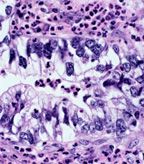HER Signaling May Explain Chemo Resistance in Lung Cancer
Increased levels of human epidermal growth factor receptor (HER) may be the key to chemotherapy resistance in non–small-cell lung cancer (NSCLC), according to a new study.
Increased levels of human epidermal growth factor receptor (HER) may be the key to chemotherapy resistance in non–small-cell lung cancer (NSCLC). A new study has identified tumor cells, already present in the tumor before chemotherapy, that express higher levels of NRG1 signaling, mediated by the HER4 receptor, which are able to confer resistance to chemotherapy treatment in a lung cancer model. Inhibiting HER4 signaling can prevent primary tumor growth, increasing responses to chemotherapy. The study, by Ganapati V. Hegde and Erica L. Jackson, of the department of discovery oncology at Genentech in San Francisco, and colleagues, is published in Science Translational Medicine.

Clear cell carcinoma of the lung
Chemotherapy is widely used for cancer treatment and is especially pertinent for NSCLC, which is frequently diagnosed in late stage and widely treated with cytotoxic agents. However, less than 4% of advanced NSCLC patients survive 5 years after diagnosis. Responses to chemotherapy may not occur at all and are short-lived for these patients. The mechanisms for chemotherapy resistance are not known, and identification of patients who are not likely to benefit from chemotherapy remains elusive.
The researchers used mouse models of NSCLC that initially regress as a result of chemotherapy but ultimately relapse, as occurs in human patients, to identify and characterize residual tumor cells that may be responsible for the chemotherapy resistance. Using expression arrays, the data showed that NRG1 was particularly highly expressed in these residual tumor cells, as was HER2, HER3, HER4, betacellulin, and heparin-binding EGF.
Further experiments showed that tumor cells expressing high levels of NRG1 and other EGFR signaling components are present prior to exposure to chemotherapy and are enriched following chemotherapy treatment. Tumor samples from treatment-naive NSCLC patients confirmed this result.
In the tumor models, HER3 and HER4 were the predominant EGFR receptors responsible for higher NRG1 levels-the dominant drivers of primary tumor growth, but HER4 was identified as the main driver, sufficient for resistance to chemotherapy. While antibodies against NRG1, HER3, and HER4 resulted in only a small decrease in EGFR signaling, in combination with the chemotherapy gemcitabine, anti-HER4 was uniquely able to prevent tumor growth relapse after a break from chemotherapy.
Still, inhibition of the HER4 pathway did not result in tumor growth inhibition in all primary tumor models, suggesting that there are inherent differences in the main drivers of tumor growth.
Surviving cells express more of the HER4 receptor and its activating molecule, NRG1, than the rest of the cells in the tumor. NRG1, along with other molecules, activate multiple pathways that contribute to cell proliferation and survival. The results indicate that cells within a single tumor are highly varied-a signaling pathway may be turned on in one cell but off in another. In order to completely wipe out cancer, different combinations of drugs may be needed, the authors suggest. For example, adding a drug that inhibits HER4 signaling to conventional chemotherapy might lead to a more uniform tumor cell response.
“The implication here is that not all the cells in a tumor will respond to chemotherapy in the same way,” said Jackson. “Some cells, such as those with high NRG1 expression, have innate resistance to chemotherapy and are not killed by it. Therefore, if we want to achieve a more uniform therapeutic response across all tumor cells, we will likely have to combine several drugs, each of which may target a different class of tumor cells.” Combination therapies may increase both the magnitude and duration of response to chemotherapy, although this hypothesis needs to be formally tested.
The EGFR/HER family have an important role in lung cancer, with EGFR and HER2 mutations and amplifications occurring frequently. About 10% of NSCLC cases in the United States have a mutation in EGFR. The oral EGFR inhibitors gefitinib (Iressa) and erlotinib (Tarceva) are both approved for NSCLC use by the US Food and Drug Administration, and other oral EGFR inhibitors and anti-EGFR antibodies are in development for lung cancer.
HER4 mutations have been identified in a comprehensive somatic mutation study of lung cancers. The current study suggests that targeting HER4 could be a way to address lung cancer chemotherapy resistance. “Inhibition of the [HER3/4] signaling axis in combination with conventional chemotherapy could be a therapeutic strategy for a broad NSCLC patient population for whom no targeted therapy currently exists,” state the authors.
“Because most lung cancer patients are treated with chemotherapy, but are often not responsive or become resistant, finding a way to improve responses can really make a difference for patients,” said Jackson. “That's always our main goal, doing good science so that we can make a difference for patients.”
Next Steps
“We will certainly continue to characterize how active HER4 and HER3 signaling enables NSCLC tumor cells to tolerate chemotherapy and also explore how widespread this phenomena is within this disease,” said Jackson. Although tracking the gene expression changes of a patient’s tumor in response to chemotherapy would be ideal, this approach is not currently feasible because obtaining tumor samples is a highly invasive process.
“We are working on obtaining patient tumors that were resected after chemotherapy treatment to assess NRG1 and HER4 levels relative to naive tumors, but neoadjuvant therapy is not an established treatment paradigm for NSCLC, so these samples are also rare,” added Jackson. The team is also studying whether activation of the HER5 pathway also contributes to chemotherapy resistance in other cancer types.